☰
This blog will help you guide on how to get on the first page of Google and what are the important factors that improve the ranking on search engines.
“What is the best place to hide a dead body?”
The Answer: “On the second page of Google.”
Sure, it sounds crazy. But there’s some truth in this statement.
75% of Internet users never scroll past the first page of Google search results, demonstrating the importance of your website’s page rank.
If your site is present at the top of Google search results, you will get an abundance of natural traffic and significant visibility.
It’s the dream for businesses that don’t have a massive advertising budget.
This blog covers all the necessary steps you can follow to improve your ranking and drive traffic to your website.
Though no one can guarantee the way to be on google’s first page, following some basic steps and using these strategies can make sure that you start ranking higher on Search Engine Result Pages (SERPs).

With the advancement of mobile computing with the ability to pack in powerful chipsets into smaller and smaller devices and the advent of super-fast networks, society has adapted to a mobile-centric focus.
Not to mention the advent of tablets and touchscreens in a variety of sizes, your website must be built with a responsive design to flex and adjust to any screen size.
A responsive website is fundamental to a positive user experience.
A responsive website also directly affects SEO score, and an unoptimized webpage could be one of the reasons why your website isn’t ranking well on Google.
Here are five benefits of having a responsive website design for your hotel or restaurant:
There are many more advantages to having a responsive website design. We have a dedicated blog that explains how your website and business can benefit from adopting a responsive website design for your hotel or restaurant.

Want to rank higher in Google’s SERP with a slow-performing website, then good luck to you! The reality is: it won’t happen.
Google PageSpeed Insights (PSI) reports on a webpage’s performance on mobile and desktop and suggests how that page may be improved with coding optimizations.
Site load speed is critical for SEO, reducing your bounce rate, and maximizing conversion, but it’s not always clear where to start.
Follow the below guidelines to improve your score on PageSpeed Insights, improving page rank, and consequently your website’s performance.
On average, images constitute 21% of your page weight, so poorly optimized images can severely slow your website down.
Optimizing images decreases the file size, which in turn speeds up the load time of the page.
It is careful to ensure compression while maintaining image fidelity, especially considering that with responsive design, your images will flex to a variety of sizes, and you want to keep high resolution in larger screen monitors without sacrificing quality.
It is imperative to ensure that your website is also coded to perform queries and page load sequencing smoothly.
If your application code has issues or your SQL queries are inefficient in accessing your database, your page load times will suffer.
In the absence of a caching plugin, the following happens:
Sometimes this process can be tedious if you are not using high-performance hosting.
Installing a caching plugin leads your site to load faster and present itself more readily to increasingly impatient customers who expect instant results.
This happens as the plugin creates a static version of the web pages of your website.
So, when a visitor clicks on your website's page URL, the caching plugin shows a saved static version in less time.
Statistically, most visitors to your website will give up and leave if your site takes longer than 3 seconds to load.
The servers that the hosting service provider uses will ultimately determine how quickly or slowly your website will load client-side in the browser, so your web host must offer high-performance hardware and optimized software to dish out server requests rapidly.
It is also important to ensure high uptime, making sure your web service does not go down and stop functioning, as this can result in broken webpages and de-ranking by search engines.
Think about the last time when you searched for something on Google.
Whether you typed “how to rank at the top on google search” or “how to lose weight in 2 months,” the search engine probably returned millions of results for you to select from.
Computer-programmed calculations look at websites and determine where to rank them in SERPs (Search Engine Results Pages),
often dynamically based on a multitude of factors in a complex algorithm that rates a variety of factors including content relevance and usability, your location, and your own search history, just to name a few.
In the past, Google made few updates to its algorithms.
Today, Google tweaks its algorithms thousands of times every year, making search engine optimization more complex.
Ben Gomes, Google’s Vice-President of Engineering, said, “our goal is to get you the exact answer you’re searching for faster.”
Google has a novel approach to naming its feature launches and has utilized a variety of often cuddly creatures to name its major search engine feature set launches over the years.
Let’s go through the most significant Google Algorithm Updates below:
On February 24, 2011, the Panda update was rolled out.
It targeted cleaning up search results to reduce duplicate or plagiarized content and thin sites with limited SEO focus to prevent them from gaming page rank on Google’s top search results.
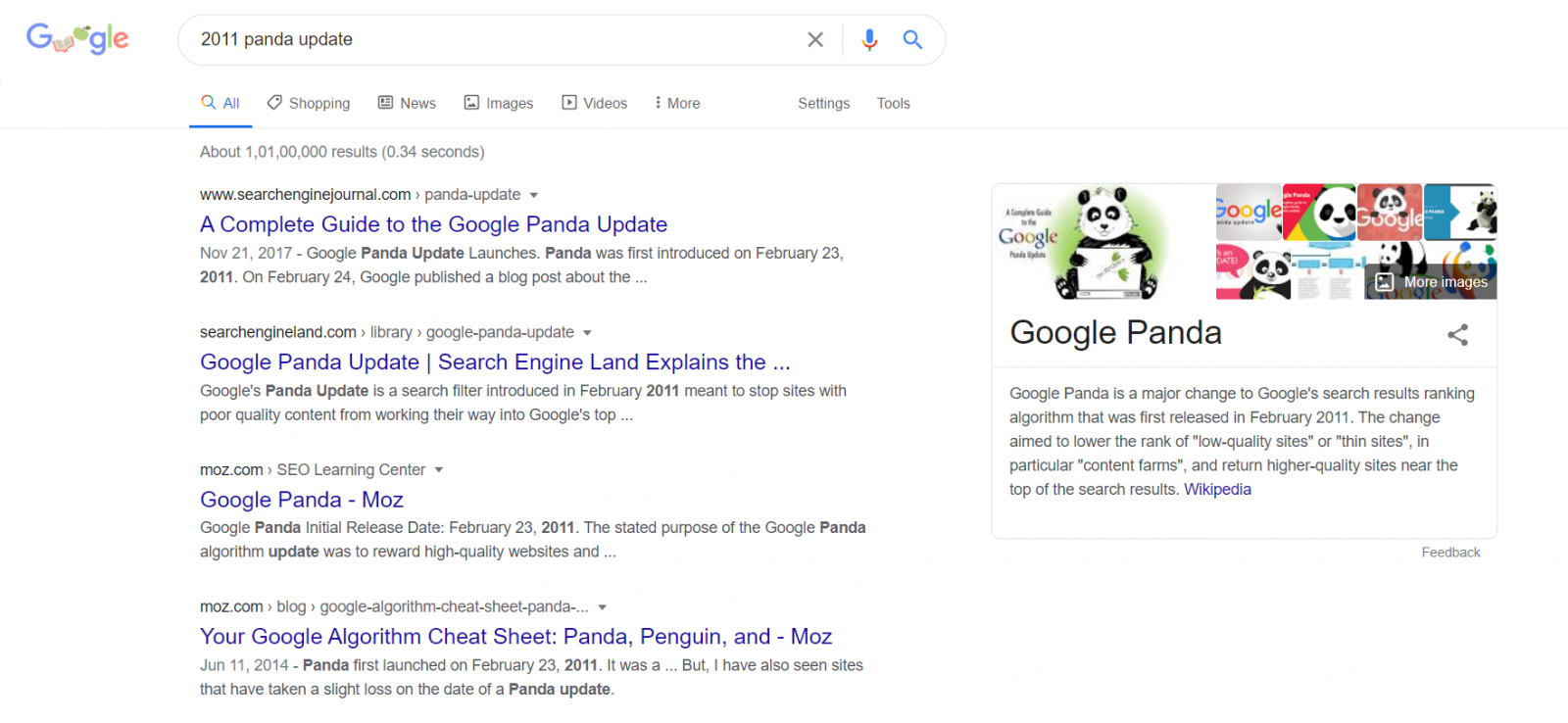
Tip: Make sure you upload ORIGINAL and SEO-FRIENDLY content on your website.
On April 24, 2012, Google launched the Penguin update (also known as the Webspam Algorithm Update) to penalize spammy or irrelevant backlinks.
Tip: Links are still significant, but high-quality links are the best way to improve search ranking.
Launched on August 22, 2013, Hummingbird helped Google understand search queries more accurately semantically and display results that match searcher intent (rather than focusing on individual terms within the question).
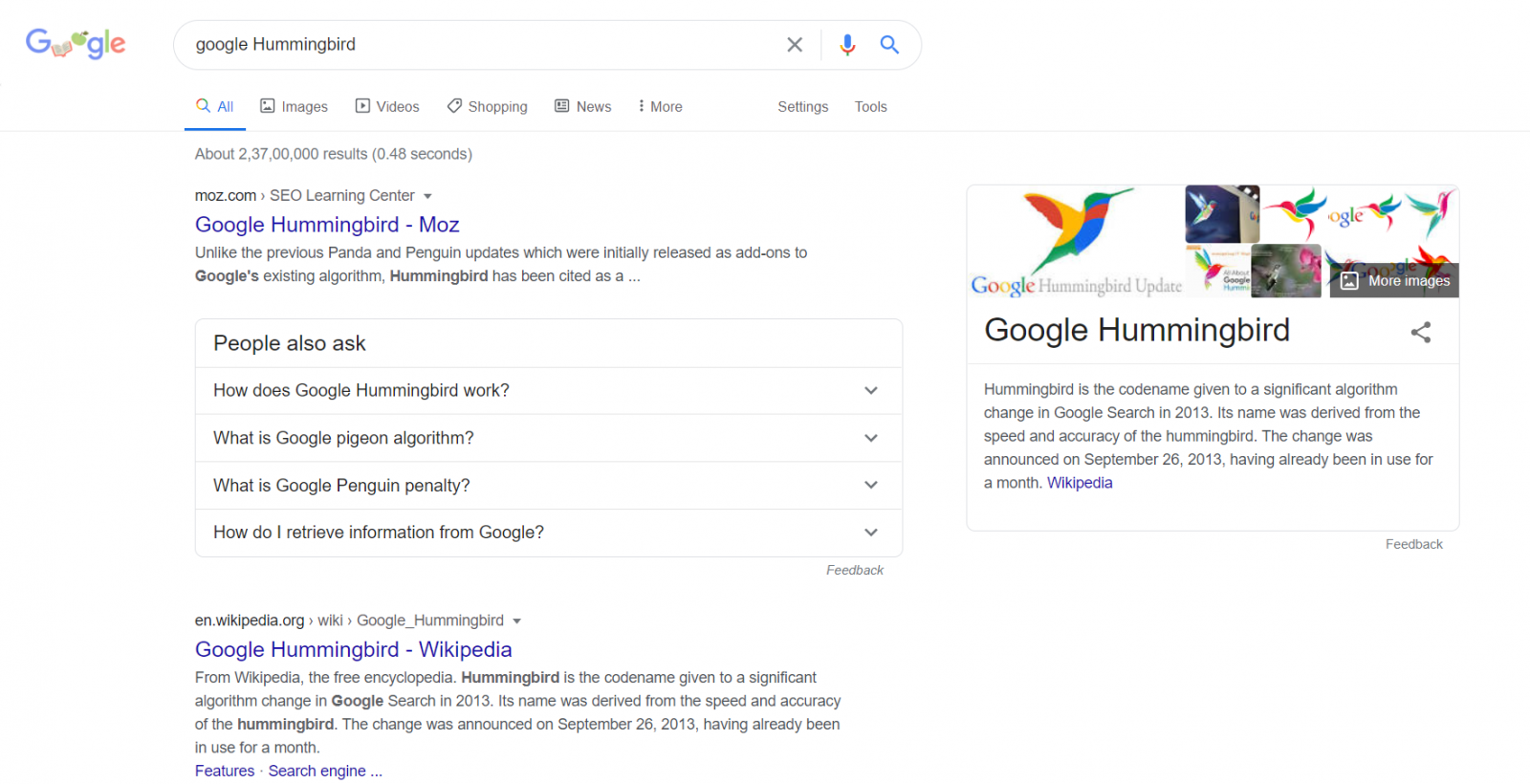
Tip: Websites that use long-tail keywords (instead of just head keywords) in the content have experienced a lot of success.
On July 24, 2014, Google launched the Pigeon algorithm to provide more relevant and useful local search results.
In other words, it emphasized the experience of the local searcher who is looking for products and services on the go.
.png)
Tip: Pigeon gave importance to local search sites and directories such as Yelp.
Google’s Mobilegeddon update was launched on April 21, 2015, to ensure mobile-friendly pages rank at the top of mobile search.
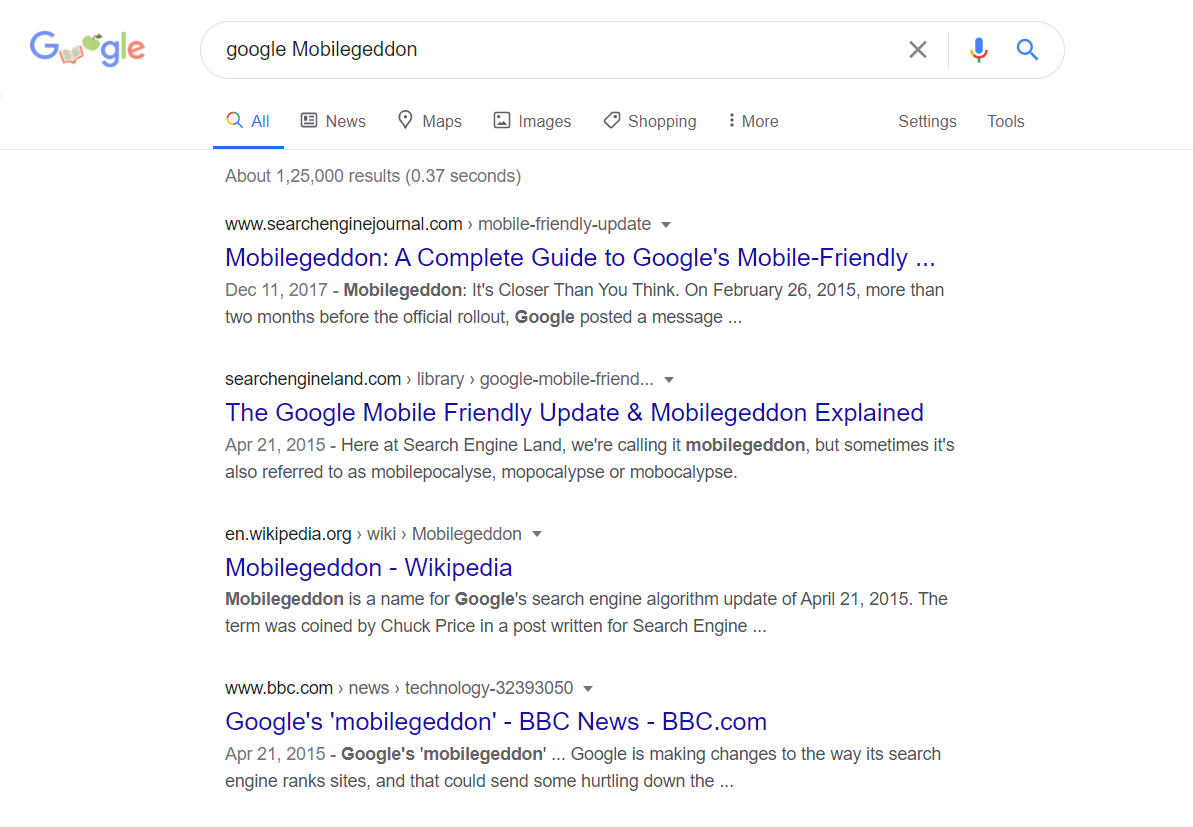
Tip: Google’s Mobile-Friendly Test will help you see which aspects of your page’s mobile version require improvement.
Fred was launched on March 8, 2017.
Fred targets websites that infringe and attempt to game Google’s webmaster guidelines, such as blogs with low-quality posts that seem to be created mostly to generate ad revenue.
Tip: Make sure the pages on which you are showing ads offer relevant and ample information.
Every year, Google’s search algorithm changes numerous times, and you may quickly learn about these updates through the Google Search Liason Twitter.
1. Measure Important Metrics
Google Algorithm Updates can take up to two weeks to roll out completely. So if you don’t see any traffic fluctuations right away, you need to hold your nerve for a while.
Check your website’s traffic data two weeks after the update and compare your website performance with the previous period.
If you see a dramatic negative scaleback, you will need to optimize your website to adjust to the new algorithm.
Below are some essential tools that you can utilize to track your website’s performance from an SEO-standpoint:
2. Re-Evaluate Your Website
Sometimes things can get dicey with your website traffic and online business performance after an algorithm update, but it's vital to remember that these updates are made to provide a better user experience.
Here are some crucial tips that you can follow to recover your website's ranking if a Google Algorithm Update has negatively impacted it:
A. Resolve Technical Issues
You simply cannot ignore technical SEO! If Google has difficulty crawling, indexing, and rendering your content, all of your other efforts can be pointless.
B. Remove Low-Quality Content
If you find low-quality content on your site, such as thin or duplicate content, then consider removing/no indexing that section of the website immediately.
C. Avoid excessive ads
Sites that are negatively impacted by Google algorithm updates often have misleading and disruptive ads.
Make your website appear much more trustworthy for both Google and your visitors.
3. Keep Generating Good Content
Google expects you to “ensure you are offering the best content you can.” Ask yourself a few questions while creating content for your website, such as:
Ultimately, you need to develop a website that satisfies your visitor’s needs and help them find the information they are looking for and achieve the tasks they seek, which always offers a positive ranking signal!
Featured Snippets are short snippets of text and pictures that appear at the top of Google’s search results to quickly answer a searcher’s query.
It can look like this:
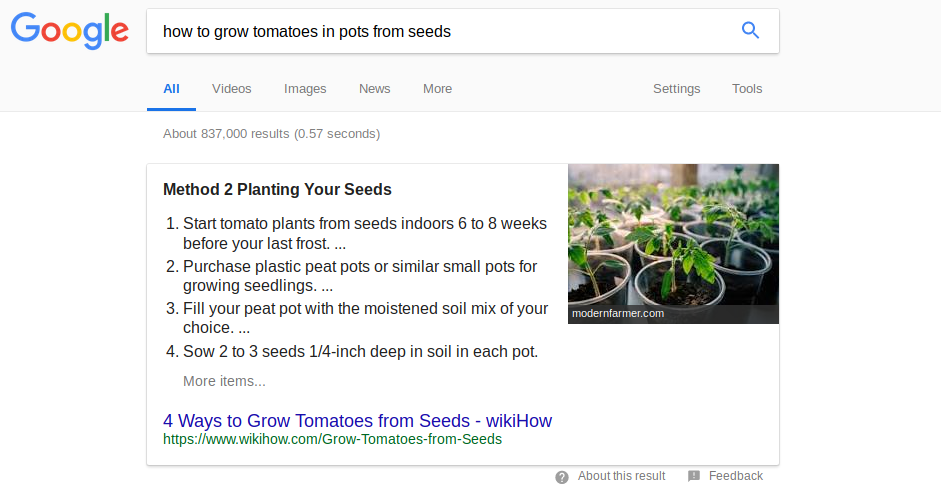
Featured Snippets impact SEO in the following ways:
First, Featured Snippets allow you to get more clicks from organic search results without ranking higher in SERPs.
Many SEO specialists refer to the Featured Snippet box as “Position #0” because it surfaces above the traditional #1 spot.
Second, Featured Snippets boost the number of “no-click searches.” In other words, when a user does not click on any of the below search results.
That’s because the Featured Snippet often gives someone the answer they’re looking for instantly at the very top of the page.
According to Search Engine Land, a Featured Snippet gets approximately 8% of all clicks.
1) Paragraph
It shows paragraph-type answers to users' queries like what, how, why, where, which, and who. The screenshot given below is an example of a paragraph featured snippet.
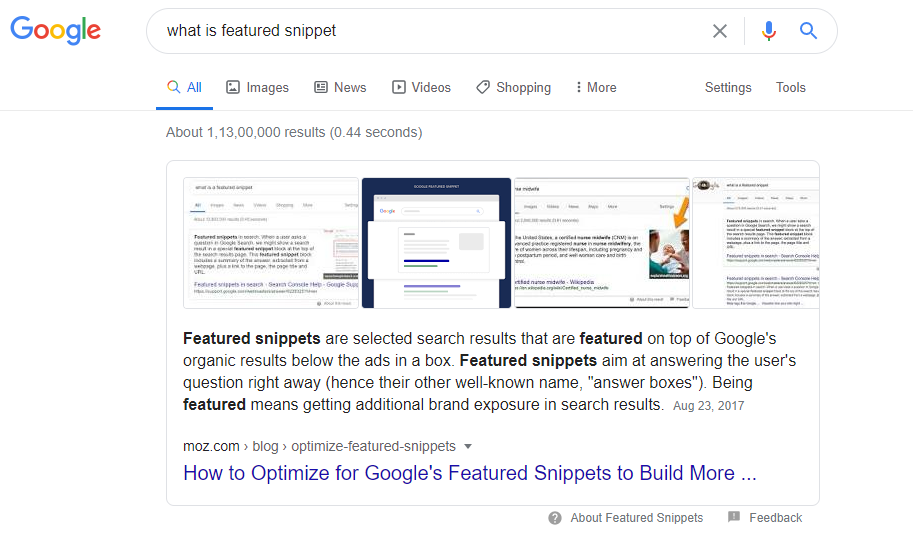
2) List
Answers that are displayed in bulleted lists or numbered lists fall under this snippet type. It mostly applies to posts with step-by-step instructions such as recipes.
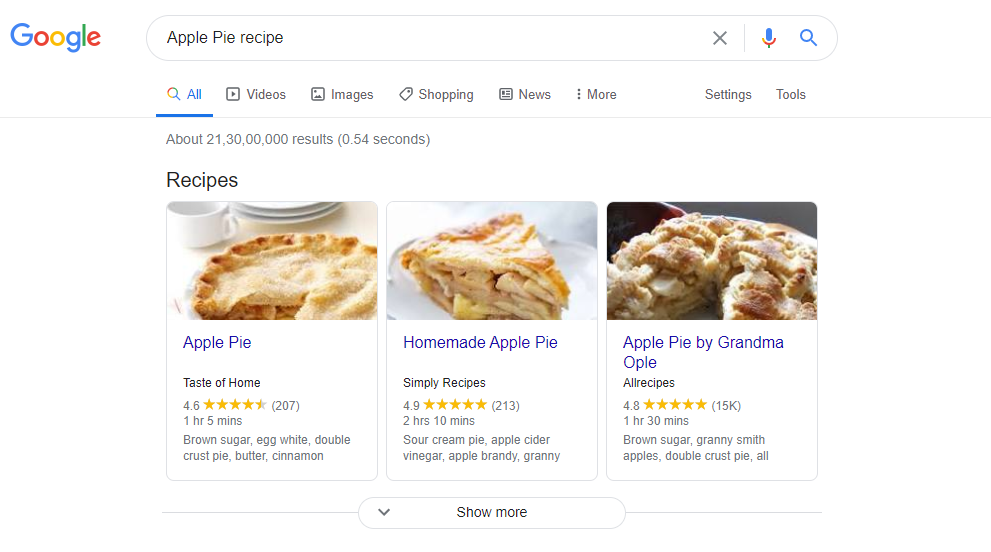
3) Table
Table Featured Snippets show well-structured content with prices, rates, years, and other numerical data.
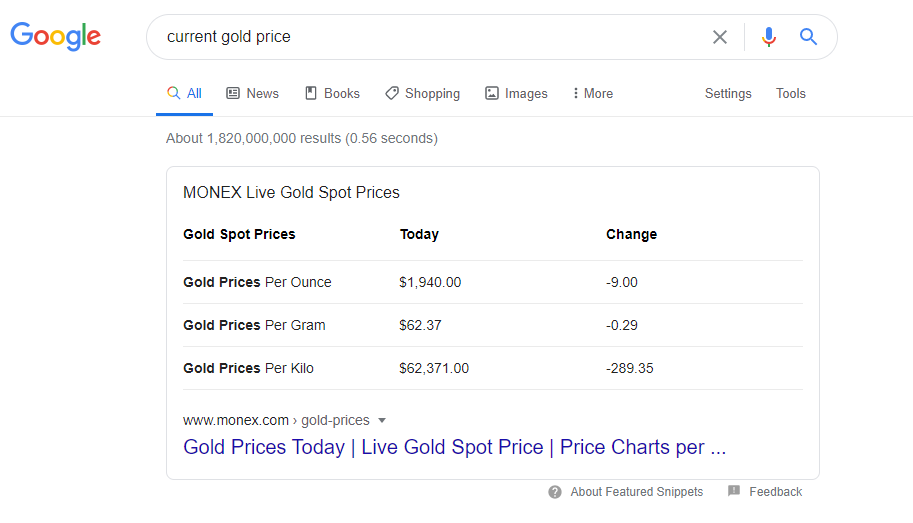
1) Find keywords where Google offers a featured snippet:
2) Focus on long-tail keywords:
3) Pay Attention to On-Page SEO:
4) Find Competitors’ Snippets:
5) Use Data-Driven, Well-Structured Content:
6) Use High-Quality Images and Videos:
7) Add “How-To” Sections to Your Website:
Tip: As voice search dominates 2020 and beyond, the popularity of featured snippets will only increase as this semantically organized content is perfect for artificial intelligent voice search algorithms.
As voice search dominates 2020 and beyond, the popularity of featured snippets will only increase as this semantically organized content is perfect for artificial intelligent voice search algorithms.
Choosing relevant keywords is the basis of successful Search Engine Optimization. Selecting the right keywords for your business can connect you to many new customers; simultaneously, choosing the wrong ones can waste your money, time, and effort.
Keeping an eye on your competitors is essential; if you get an idea of what works for your competitors, you can reduce a lot of trial and error. You can find out how others maximize the results of their rankings by learning from their work.
Ranking for targeted keywords can have a very high financial value
A Search Term Report shows you the value of each ranking that your competitors maintain.
The value is calculated based on the keywords' monthly search volume, the rankings’ position in the search results, and the price per click the competitor would have to pay to advertise for those keywords.
Compare your website rank performance to your competitors and discover your strengths and weaknesses. Find where you are lagging by working on the Key Performance Indicators (KPIs) and increase website visitors. Use the tool’s comprehensive filters that enable you to find the relevant keywords that you should embed.

Find out which pages of your competitors’ websites have the highest rankings and drive the most visitors. Also, routinely analyze your competitors’ pages and keep improving the content of your pages accordingly.
The significance of comparing your metrics to your competitors' performance is that it will help you develop a better website performance strategy and help you outrank their web pages for similar search terms.
You will also get a clearer picture and overview of all the websites that compete with yours for the same keywords.
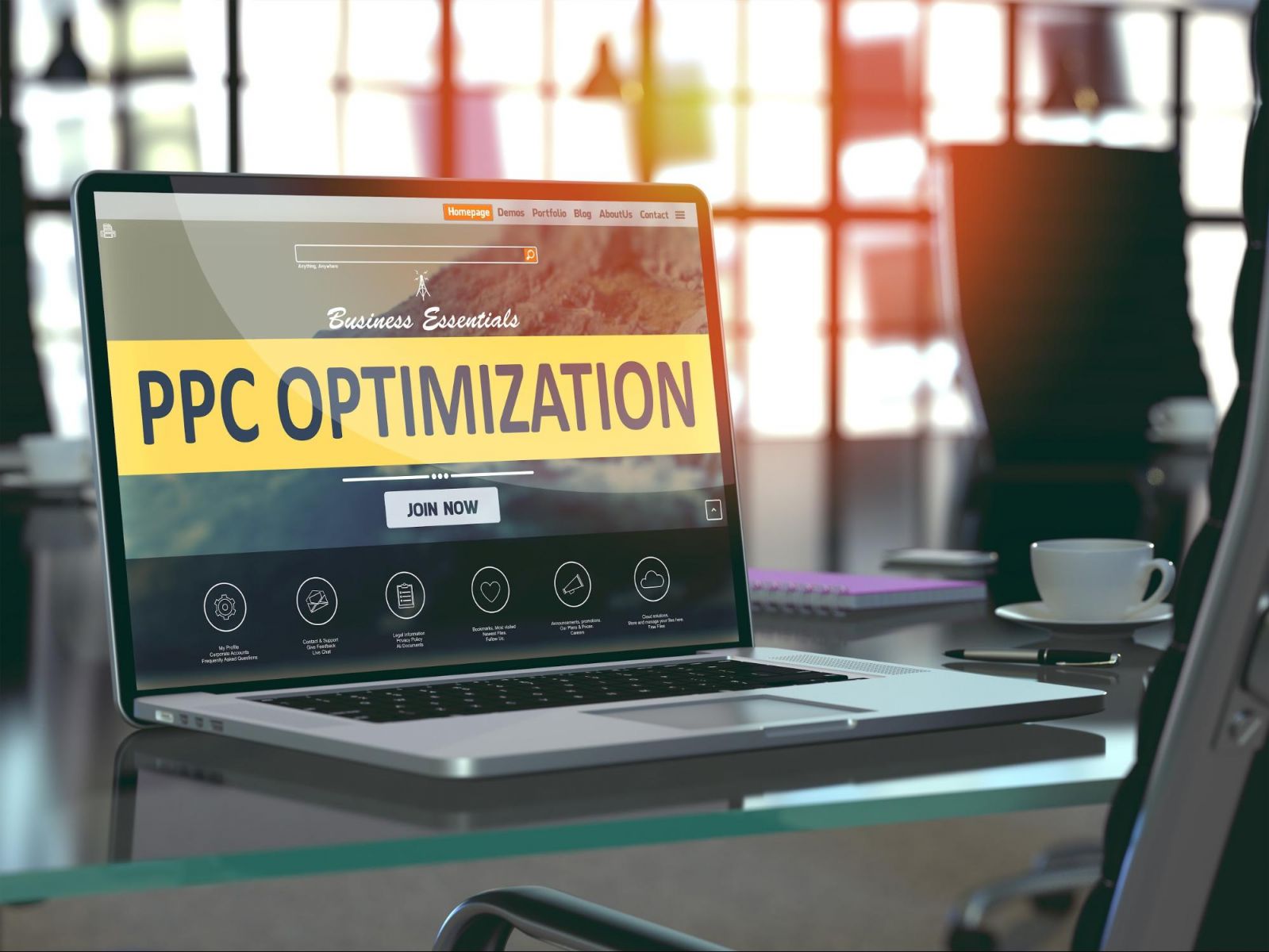
Google Ads is a paid online advertising platform under a marketing channel called Pay-Per-Click (PPC). The advertiser spends for each click or impression, depending on your chosen strategy, and a pricing algorithm routinely based on bidding up keywords.
Google Search Ads is an effective way to drive relevant traffic to your hotel business while travelers search for services like those you offer.
It's no longer a secret that the more robust and more relevant your Google paid campaigns are, the more clicks your website will generate, leading to a higher probability of obtaining new customers and ranking at the top of results pages. That is why Google Ads has become increasingly popular among businesses across all industries, including the hospitality industry.
Google is the most used web search engine, getting some 3.5 billion search queries a day. According to Google, advertisers get $8 for every $1 they spend on Google Ads. Hence, there are a few reasons why you should want to consider advertising on Google.
Need one more reason? Well, your competitors are using Google Ads, and they might even be bidding on your branded terms. Hundreds of Thousands of businesses use Google Ads to promote their hotels, which implies that there is a possibility that even if you’re ranking organically for a search term, your results are being pushed down the page, below your competitors.
Thus, if you’re using PPC to advertise your hotel, Google Ads should be an essential part of your overall paid strategy.
Tip - When you run your search ad campaign, keep in mind that bidding on a keyword doesn’t assure you’ll always show up at the top of Google’s search results page. If your competitors bid more for a click, there’s a possibility that you’ll appear lower, or not at all.
Other crucial factors that impact your ranking are your landing page and ad copy. It’s important to note that your landing page and ad copy align with your targeted keywords. Google’s Quality Score provides you with some useful insight into this. Google says, “Higher Quality Scores typically lead to better ad positions and lower costs.”
Lastly, while ads are a fantastic way to appear at the top of Google fast, it’s 100% pay-to-play. The moment you stop investing money into your campaigns is when you stop showing up at the top of Google SERPs.

When working on getting your website to the top of Google’s Search Results, it is not practical to solely think of targeting just about any keyword that comes to your mind. The search engine results for keywords such as “ Hotels,” “Hotels,” and “Hotel Booking at ” are saturated and highly dominated by Online Travel Agents (OTAs) and other well-established websites. Although these keywords are more commonly used, they have very high competition that could make it unrealistic for your website to reach the first page of Google SERPs.
That's when long-tail keywords come into play.
Focusing on long-tail keywords is the perfect strategy to target your hotel or restaurant website's right audience. Therefore, it is smart to focus on long-tail keywords rather than commonly used short keywords to rank your website higher on SERPs and bring more traffic and bookings from the right group of targeted people.
Let's take an example of a San Francisco hotel that is located near the Golden Gate Bridge and is also a pet-friendly hotel. So, if someone searches for "San Francisco hotels," you aren't exactly sure what kind of hotel they're looking for. But if they search for "pet-friendly hotels in San Francisco," or "San Francisco hotel near the Golden Gate Bridge," you would have more insight into their search intent. Therefore you can easily rank for these search queries if you utilize these long-tail keywords in your ad copy, website copy, and Google AdWord buys.
.jpg)
Backlinks are one of the most effective ways to increase your website's rankings. Search engines consider links to your website as a vote of confidence in the quality of your website's content.
However, getting backlinks is like walking on a tightrope. You have to be extremely cautious that your link-building methods are white hat and ethical. The black-hat technique of getting/buying bulk backlinks from low-quality spammy websites doesn’t work anymore.
Google also values the quality of your backlink more than the number of backlinks your website has. Therefore, a small amount of fittingly earned links from authoritative sites will significantly impact your website rankings compared to many links received from low-quality spammy websites.
Also, remember that backlinks acquired from these low-quality spammy websites can even harm your website’s ranking, throwing all your other SEO efforts down the drain, all thanks to Google’s Penguin update in 2012.
Some recommended ways that you can get high-quality backlinks to your website are:

How can you ever forget the age-old advice? "Content is king."
There is no way for your website to rank without unique content material on it. And what better way to include more content on your website and keep it regularly updated than with your very own BLOG?
Creating unique and original content that caters to your audience well should be an essential point in your online marketing strategy.
Before starting to write blog posts, take some time out to identify the kind of audience you would like to target through your blog posts and how it will help in improving your bookings. Research your competitor hotels and restaurants, and understand what kind of content they are publishing and what response they are generating with their blogs.
There are many blog posts available on the internet for virtually any given topic. What you need to do is to stand out from the rest. Your blogs can have a unique style and cover interesting topics that attract readers and keep them hooked to your blog.
Perform thorough keyword research and make sure to include them in your content. Try to write longer and more detailed blog entries than your competitors. Also, keep in mind to blog frequently and keep your content fresh and high quality.
Writing blogs won't get your readers to convert into guests right away. But most importantly, it will leave a lasting impression, and when they're ready to convert, they will come back to your website. So, if you have the time and resources to write unique and exciting content regularly, creating more blogs than your competition is a pretty great way to help index higher on Google search results.
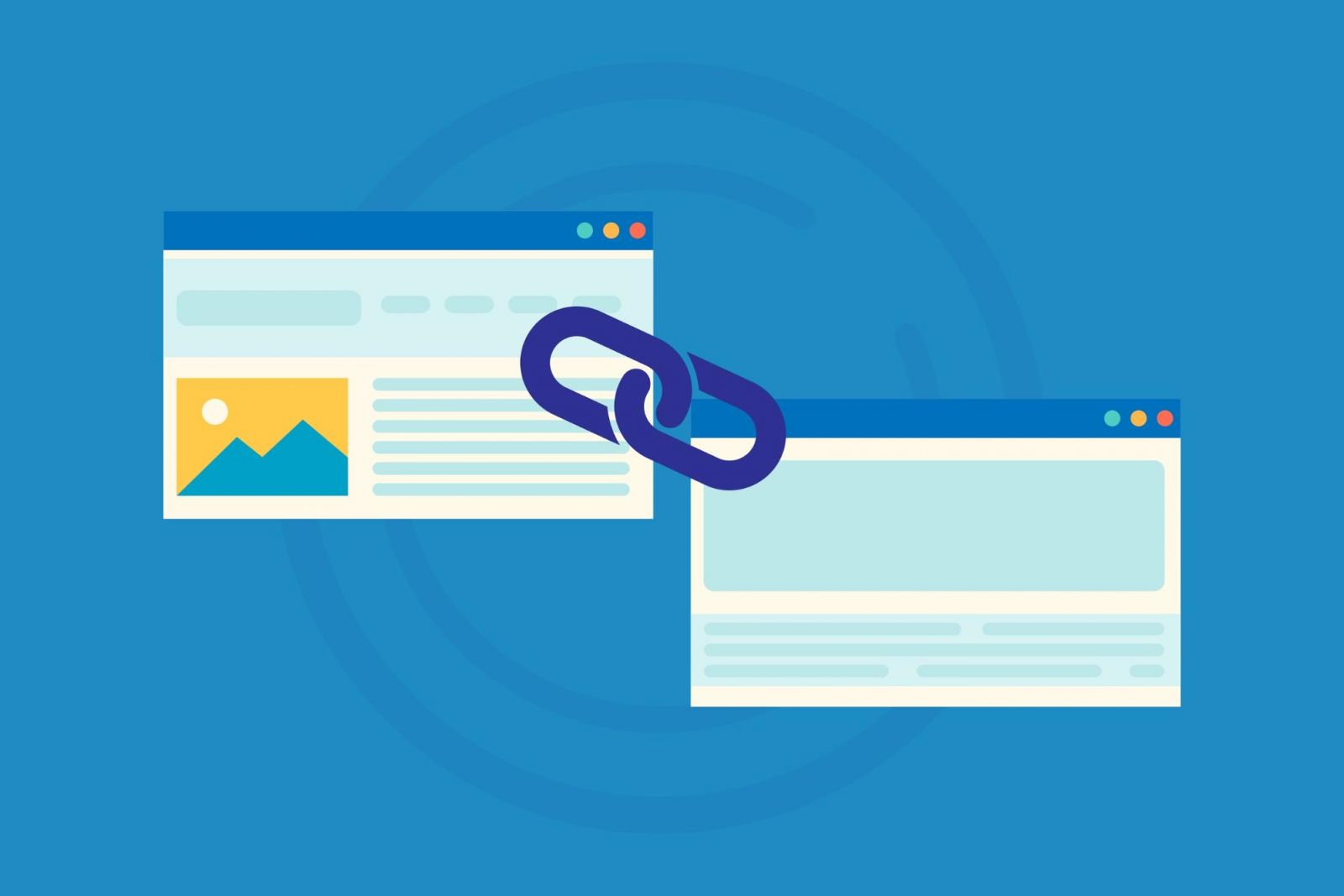
Merely saying, Internal linking is establishing the linking from one page of a website to another webpage of the same site.
Internal links are also considered backlinks.
You know how important it is to create an excellent backlinking strategy; the same applies here too. It is essential to develop sensible internal links to make your website more user-friendly and easy to navigate.
Internal links pass link juice, or value worth promoting, and tell search engines which pages are more important. Skillfully established internal links form better user experience, a higher conversion rate, and more efficient website crawling.
Best practices to create useful internal links on your website include:
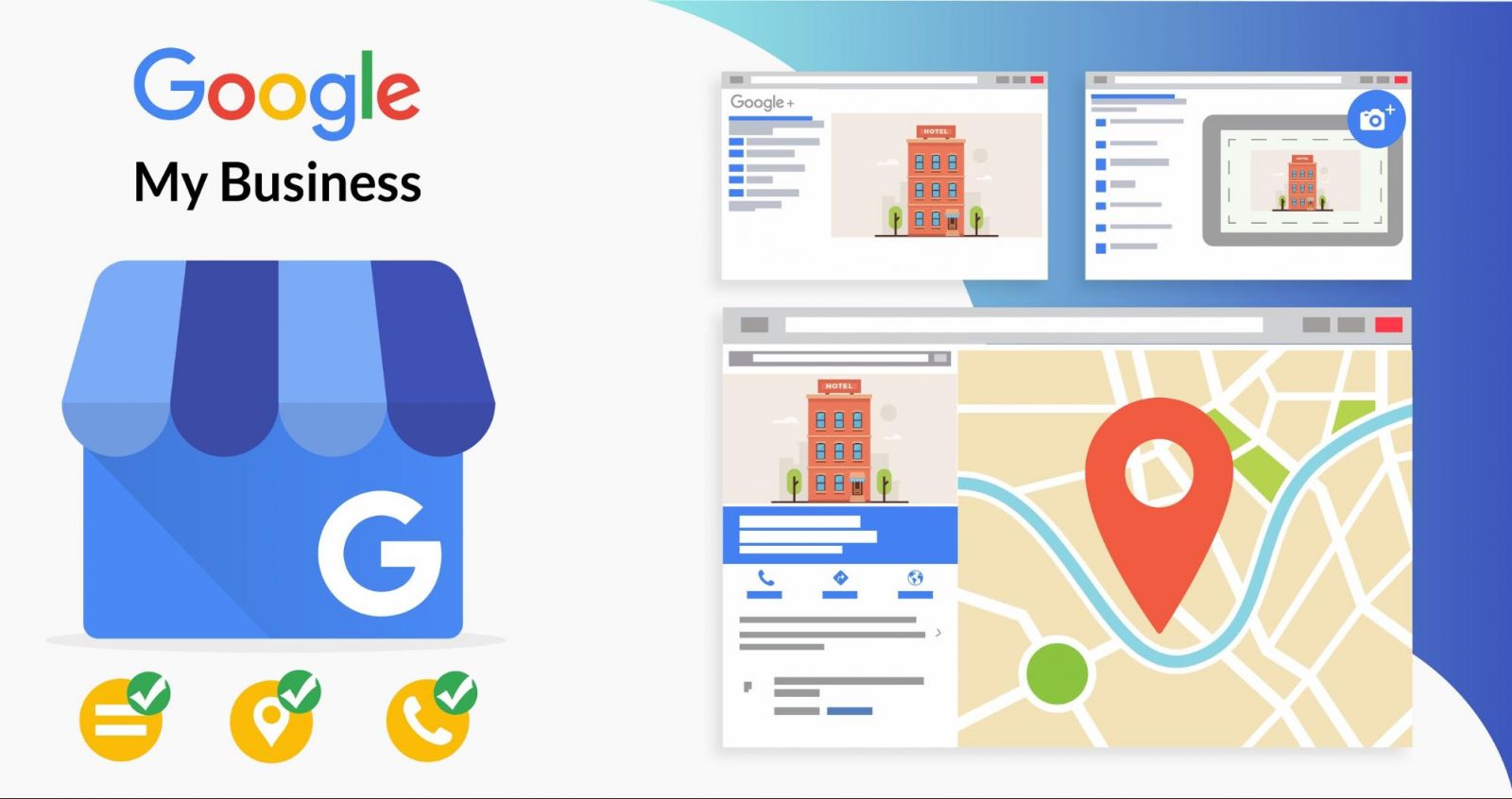
GMB assists the small business owner in managing information about their business and communicating with visited guests or potential customers.
Always make sure you deliver up-to-date information about your:
Best Practices to optimize your GMB listing:
You can drive enormous amounts of traffic with the step-by-step guide to optimize GMB listing. It is integral to set up your Google My Business listing correctly and imperative to have your website URL listed as the authoritative site, as Google will use this URL as the actual website associated with your business. If your website URL is not listed on GMB, there will be difficulty in reaching the top of page 1 of SERP. This is quite common with franchised hotels, where the franchise, in many ways, illegally squats the hotel’s website parameters on Google My Business listings and drives traffic to their landing page, circumventing you from not only directing traffic to your website but also reducing your standalone or vanity website’s page rank.
So, basically, when you want to do SEO for any business website, you have to follow all the above-mentioned steps. It is how you can use this article for SEO for hotels too.
Ranking on the first page of Google has some level of mystique. But there are some strategies, tips, and tricks that help your website rank well on Google SERP.
We at INNsight are successful in increasing more direct bookings, and expanding margins while driving top-line revenue growth by improving our clients’ websites.
INNsight is the hospitality digital marketing and property management software leader that simplifies and automates your hospitality marketing and business operations.
INNsight is built on a proprietary software framework that offers SEO-friendly website design driven by a robust Content Management System, data processing security, ADA Title III compliance, and high performance hosting and uptime with dedicated cloud-based server architecture; websites Powered by INNsight are tuned to perform and achieve top page ranking on Google.
We take the guesswork out of internet marketing for hotels and help achieve your direct booking revenue milestone.
If you want our team to help you achieve your marketing goals and drive more direct revenue, contact us today!
By submitting your email address, you confirm that you would like to receive marketing emails from INNsight. In addition, you agree to the storing and processing your data by INNsight as described in our privacy policy.

